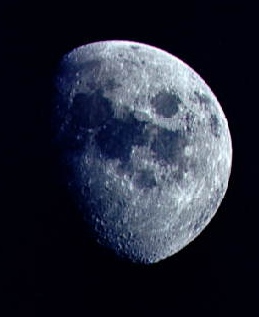This image shows both a visible and a thermal infrared image taken by the thermal emission imaging system on NASA's 2001 Mars Odyssey spacecraft on November 2, 2001. The visible wavelength image, shown on the right in black and white, was obtained using one of the instrument's five visible filters. The spacecraft was approximately 22,000 kilometers (about 13,600 miles) above Mars looking down toward the south pole when this image was taken. The thermal infrared image, center, shows the temperature of the surface in color. The circular feature seen in blue is the extremely cold Martian south polar ice cap. The instrument measured a temperature of minus 120 degrees Celsius (minus 184 degrees Fahrenheit) at this ice cap.
Click on image for full size
NASA/Jet Propulsion Laboratory/Arizona State University
Mars Odyssey
The Mars Odyssey was launched April 7, 2001, from Cape Canaveral Air Force Station in Florida. After a six-month, 285 million-mile journey, the Odyssey arrived at Mars on October 24, 2001 (02:30 Universal Time). The Odyssey is in its aerobraking phase right now. After about 3 months of aerobraking, the final science orbit should be achieved and the real science of the mission will start!
The spacecraft is carrying a gamma ray spectrometer (GRS). The gamma ray spectrometer was inherited from the lost Mars Observer mission. The GRS onboard the Mars Odyssey will help detect the presence of water on the surface of Mars. The GRS will also measure the abundance and distribution of about 20 primary elements of the periodic table, including silicon, oxygen, iron, magnesium, potassium, aluminum, calcium, sulfur, and carbon at the surface of Mars.
Other instruments onboard the Odyssey include the Thermal Emission Imaging System (THEMIS) and the Mars Radiation Environment Experiment (MARIE). MARIE will investigate the amount of radiation present at and around Mars. This would be pertinent information to know if humans were to colonize Mars. THEMIS is a camera system that will study the Martian surface in both visible and infrared light and will help determine
what minerals are present. It also will map landscapes on Mars at resolutions comparable to that of NASA's Landsat Earth observing satellite.
Other than our Moon, Mars has attracted more
spacecraft than any other object in the solar system. Of course, no
other solar system object has been as daunting to visit. Of the 30
missions sent to Mars by three countries over 40 years, less
than one-third have been successful.
You might also be interested in:

What types of instructional experiences help K-8 students learn science with understanding? What do science educators teachers, teacher leaders, science specialists, professional development staff, curriculum designers, school administrators need to know to create and support such experiences?
...more
Minerals of a planet's surface, and molecules of an atmosphere emit light of various wavelengths. The wavelengths of light which minerals or molecules emit is characteristic of each individual mineral
...more
The Mars Observer set out to observe the atmosphere (detailed weather rather than climate), magnetic field and surface of Mars. It carried with it 8 instruments. However, the Mars Observer (MO) failed
...more
The presence of water near the surface of Mars, or lack of water, is a big factor in determining the climate of Mars, and the suitability of Mars to support life. Finding out what has happened to the water
...more
The uniquely red global surface of Mars is marked by many interesting features - some like those on the Earth and others strangely different. The reddish color is caused by rust (iron oxide) in the soil.
...more
The Earth's one natural satellite, the Moon, is more than one quarter the size of Earth itself (3,474 km diameter), making the Earth-Moon system virtually a double-planet. Because of its smaller size,
...more
43 Scout missions were proposed to NASA. 10 were selected. These 10 are competing to see which will be included as future Scout missions to Mars. May the best robots, gliders, rovers, orbiters or landers
...more
Researchers working with data from the Odyssey spacecraft have some interesting new information about the water and rocks on Mars. Earlier this month they announced their exciting new findings. The researchers
...more















